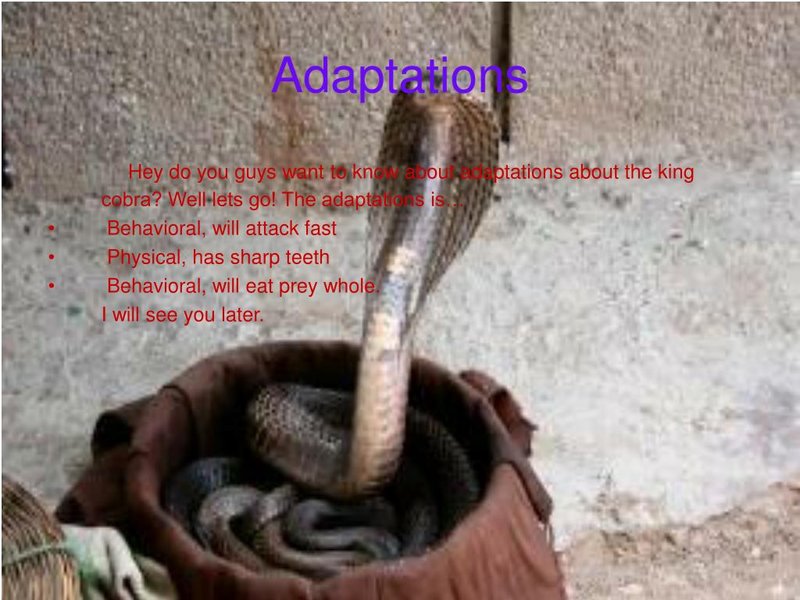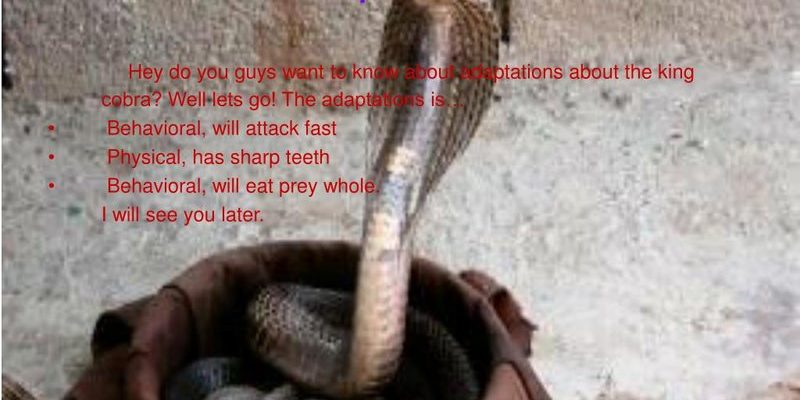
You might wonder—what exactly makes the king cobra stand out among the thousands of snake species? Well, it’s not just its size (which can reach up to 18 feet!). There’s a whole lot more going on beneath that striking scales and hood. The adaptations of the king cobra are like nature’s clever little tricks, allowing it to live, hunt, and even thrive where many other animals might struggle. So, grab your cup of coffee, and let’s explore the incredible ways this serpent has conquered the wild.
1. Venom: Nature’s Lethal Weapon
Let’s be real: when you hear “king cobra,” the first thing that likely comes to mind is its venom. King cobras possess some of the most potent venom in the snake world. This isn’t just for show; it’s a critical part of their survival strategy. The venom contains a cocktail of neurotoxins that can quickly immobilize their prey, usually consisting of other snakes.
Here’s the thing: this venom isn’t just about killing food. It also deters potential predators. When other animals see a cobra’s impressive display and know about its venom, they usually think twice before approaching. This gives the king cobra a significant advantage in the wild.
How the Venom Works
So, how does the venom do all this? Once injected into prey, the neurotoxins disrupt their nervous system, leading to paralysis. It’s like a switch being flipped; the prey simply can’t move anymore, making it easy for the cobra to swallow its meal whole. This adaptation helps the king cobra conserve energy because it doesn’t have to chase down its food. Instead, it can rely on its stealth and patience to strike.
2. Size and Agility: A Perfect Blend
The king cobra isn’t just about venom; its size plays a huge role in its survival, too. As one of the longest snakes in the world, this species can stretch up to 18 feet! But don’t let its length fool you—it’s also surprisingly agile. This combination makes the king cobra a formidable predator.
Imagine trying to run away from a 15-foot snake that can move quickly and smoothly through bushes and trees. It can easily navigate its environment, whether it’s thick jungle or open fields. Plus, its size allows it to dominate smaller snakes, which are common in its diet.
Camouflage and Stealth
The king cobra’s coloring also aids in its survival. Its scales are typically a blend of brown, green, and yellow, allowing it to blend in seamlessly with its surroundings. This natural camouflage helps it ambush unsuspecting prey. Honestly, spotting one in the wild is no easy feat—unless it wants to be seen!
This ability to remain hidden until it strikes makes the king cobra a master of surprise, adding another layer to its hunting success.
3. Highly Developed Senses
You might be wondering how a snake, which relies on touch and taste rather than sight, can effectively hunt and navigate its environment. The king cobra has exceptionally developed senses that help it locate prey even in tricky situations.
Its tongue plays a significant role in gathering chemical cues from the air. When it flicks its tongue in and out, it’s actually “tasting” the air for scents. Kind of like a detective sniffing for clues! Once it picks up on the scent, it can follow it to locate its next meal.
Vibrations and Heat Detection
In addition to its remarkable sense of smell, the king cobra can detect vibrations in the ground. This is crucial for staying aware of potential threats, whether they’re other snakes or even human footsteps. Moreover, it has heat-sensing pits located between its eyes, allowing it to detect the body heat of warm-blooded animals nearby.
This ability is especially important during nighttime hunting when visibility is low. The king cobra effectively uses these adaptations to stay one step ahead of both prey and predators.
4. Unique Reproductive Strategies
When it comes to reproduction, the king cobra employs some fascinating strategies that contribute to its survival as a species. Unlike many snakes that lay eggs and abandon them, female king cobras take a more hands-on approach. They guard their nests and even wrap around them to keep them warm and safe from predators.
This protective behavior increases the chances of survival for the hatchlings. After about 60 to 80 days of incubation, the young snakes break free from their shells and begin their lives, already equipped with essential survival instincts learned from their mother.
Choosing the Right Habitat
Another crucial aspect of reproduction is selecting an ideal habitat. King cobras tend to thrive in diverse environments, from tropical rainforests to grasslands. By choosing spots with ample food sources and shelter, they increase the likelihood of successfully raising their young.
This adaptability in habitat choice is a key survival tactic that enhances their chances of not just living, but flourishing.
5. Defensive Mechanisms: More Than Meets the Eye
When threatened, the king cobra doesn’t just back down—it puts on quite a show. With its distinctive hood, the cobra can appear larger and more intimidating, warning potential threats to stay away. It’s a bit like puffing up your chest before a big confrontation!
If intimidation doesn’t work, the king cobra won’t hesitate to strike. It can deliver a bite that is not only painful but potentially lethal. Yet, it often prefers to escape instead of fighting, showing that survival is not about aggression alone but also about knowing when to retreat.
Behavioral Adaptations
The king cobra is also known to exhibit clever behavior, like raising its head and splaying its neck to look larger. This behavior is especially effective against larger threats, making them think twice before approaching.
By combining physical adaptations with behavioral tricks, the king cobra has crafted a survival strategy that’s both efficient and fascinating.
6. Conclusion: The Art of Survival
The king cobra is much more than a fearsome snake; it’s a master of survival. From its venomous bite to its clever hunting strategies, each adaptation plays a vital role in its ability to thrive in the wild. Whether it’s its impressive size, developed senses, or protective behaviors, the king cobra embodies nature’s ingenuity.
Understanding these adaptations not only helps us appreciate this magnificent creature, but it also gives us insight into the delicate balance of ecosystems. Next time you think about the king cobra, remember the remarkable strategies that make it an ultimate survivor in a complex world. Let’s continue to respect and learn from the wild, where every creature tells a story of adaptation and resilience.

